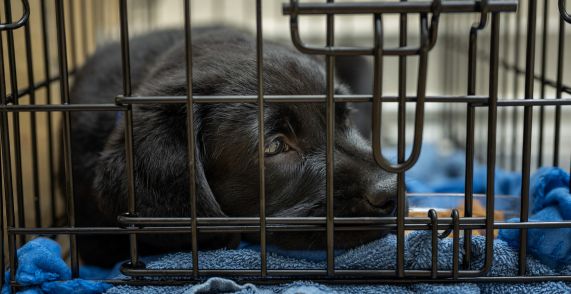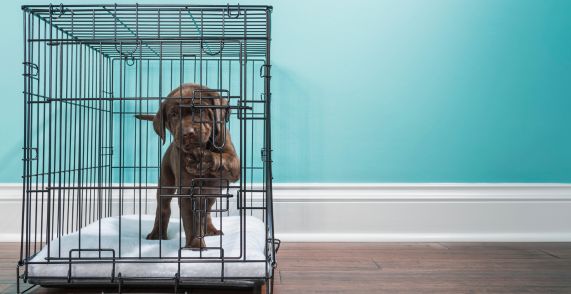Do you remember that cherished moment when, as a child, you graduated to your own room—sans the protective web of crib bars? It was the end of one era and the beginning of another—an upgrade in personal growth.
This seemingly insignificant transition is somehow quite similar to your dog graduating from night crating. Deciding when it’s time to stop crating your dog at night can be a daunting task filled with anxiety and uncertainty.
Aligning on this transformative choice with your four-legged partner can sleepwalk you into unknown realms. Yet, our comprehensive guide will lead you through this moonlit maze with insights and clarity because every pup deserves their version of a ‘big kid bed’.
The answer varies depending on your individual dog’s behavior, maturity, and level of potty training. While some dogs can be trusted outside of a crate at around 7-8 months old, others may need to be crated at night for an extended period even after potty training if they are still not fully mature or cannot be trusted to avoid destructive behaviors. It’s important to assess your dog’s specific situation and consult with a veterinarian or trainer if needed before considering leaving them unsupervised at night.
Understanding When to Stop Crating Your Dog at Night
As pet owners, one of the most significant decisions we face is when to stop crating our dogs at night. It’s a decision that should be made taking several aspects of our dog’s behavior and environment into account.
Keeping a dog locked in a crate for hours is not just cruel but unnecessary if your pup is capable of handling themselves outside the crate without causing havoc. Additionally, leaving your dog out of the crate too early can cause unwanted behavior and stress to both your puppy and you.
It’s important to understand when it is appropriate to begin phasing out nighttime crating.
Every dog is different. Some have a natural inclination towards being protective and confined, while others are more curious and lively; it’s their inherent nature.
In these cases, it becomes vital to strike a balance between the pup’s comfort and safety, as well as their training needs. Finding the right moment to abandon the crate process altogether depends on specific parameters that we’re going to address below.
First off, it comes down to evaluating how well-trained your dog is regarding potty habits outside, destructive behavior, or simply managing his energy levels during the night and daytime hours. The objective here is not solely putting an end to crating your furry companion but also keeping them away from dangerous areas within your living space.

However, eliminating crate confinement completely isn’t always feasible for less obedient dogs or puppies who tend to be rambunctious during bedtime hours.
One critical factor that must be taken into consideration here would be any potential accidents inside your home due to lack of supervision or subsequent damage caused by separation anxiety-induced destructive behavior.
Try picturing bedtime as driving down Highway 1 during rush hour: it may look like an effortless, steady journey on some days but can quickly unravel into chaos should a significant accident occurs. Same as with crating, the ease of handling varies and sways according to different scenarios.
Therefore, we must delve deeper into multiple factors that dog owners must keep an eye out for when determining whether their dog is ready to sleep outside of the crate.
Age Considerations and Behavioral Signs
Every dog has unique characteristics that influence several aspects of training. But there are different behavioral cues that are commonly observed in canines around specific age milestones.
For instance, puppies tend to be more emotionally dependent during early stages, needing constant attention from their guardians. However, as they grow older, pups might start displaying signs of separation anxiety once they’ve been left alone and become distressed without human contact for extended periods.
At this moment in time, it’s crucial to watch out for erratic behavior such as barking or whining excessively. You have to establish a pattern in your dog’s routine—take note of err behavior shown when you deviate from said timeline.

A tranquil pup throughout the day but becomes rowdy at night could be a sign that he or she needs a bit more training before comfortable transitioning out of crating.
Monitoring behavioral changes in your pup and drawing comparisons to their well-being may also serve as an indicator for taking steps towards phasing out extreme confinement within a crate setting.
Additionally, if you adopted an adult rescue dog or incoming from a bred litter and unknown background history – it may prove difficult assessing suitability. A rescue dog may suffer from past anxieties triggering them in certain nighttime situations that cause destructive behavior requiring crating until calm behavior patterns emerge.
Similar to taking care of babies versus teens learning how to interact in the “real world”, every stage comes with its unique challenges and necessary changes. In the same vein, ensuring that our furry companions are well-adapted to their environment is hugely fundamental in determining whether they’re ready to start sleeping outside of a crate setting.
With age considerations and behavioral signs explored, we must take proactive measures when preparing our dog for a comfortable crating transition process.
- According to a study published in Applied Animal Behavior Science, almost 60% of pet owners cease using their puppy’s crate by the time the dog is one year old.
- A survey conducted by the American Pet Products Association (APPA) found that around 67% of dog owners used crates for house training, and roughly 40% continue the use of crates past adolescence for safety while alone.
- The American Veterinary Medical Association (AVMA) states that most dogs can control their bladder overnight by about six months of age, which might be an initial consideration for ceasing night crating.
- Every dog has unique characteristics that affect their training, but there are common behavioral cues observed around specific age milestones. It’s important to establish a routine for your dog and monitor any erratic behavior, as this can be an indication of separation anxiety or a need for more training. As dogs change and grow, it’s essential to adapt their environment and training accordingly, especially when phasing out extreme confinement in a crate setting. Adopted dogs with unknown backgrounds may require extra care and attention to assess their suitability for alternative sleeping arrangements. Being proactive in preparing your dog for a comfortable crating transition process is crucial for their well-being.
Preparing your Dog for the Transition
Transitioning your dog from sleeping in a crate to sleeping outside of it requires preparation and patience. It is essential to ensure that your pet feels comfortable and safe when left alone and unsupervised at night.
One easy way to get started on the transition is by leaving the door of the crate open during daytime naps while you are in the same room. Doing so will help your dog get used to moving in and out of the crate, which makes them feel more confident about spending time outside of it.

Once you notice your dog relying less on the crate during daytime naps, start extending the duration of those naps until they can comfortably sleep outside their crate for several hours during the day.
Another useful tip is ensuring your dog gets enough exercise before bedtime; exercising reduces anxiety levels, making your dog sleep soundly. Make sure that all concerns threats to health and safety are addressed before transitioning to wake up late at night or early morning.
While preparing for the transition, some pet owners may be tempted to give their dogs free rein around their houses overnight without supervision.
What these owners fail to consider is how challenging this could be as night-time has its different temptations. From chewing up expensive shoes to getting stuck in corners and fretting over where their owners are, which can cause lasting damage psychologically.
Think about it like teaching a toddler how to navigate a room with sharp objects and items that could quickly lead to injury: you don’t allow them free reign without any guidance or precautions until they prove they are responsible enough!
To make this transition easier, it’s crucial to take carefully planned steps that reduce the risk of harm or injury and create a safe environment for your furry friend.
Steps for Guaranteeing a Safe and Comfortable Environment
Creating a safe, comfortable environment is an essential part of transitioning your dog to sleep outside their crate. This involves ensuring that the room they will be staying is free of hazards, and the bedding they will rest on is clean and cozy.
Remove all items in the room likely to be chewed or pulled over by dogs—these can include cords, flowers or plants hazardous to pets, medications, and cleaning solutions. Remove anything likely to harm the dog if chewed or swallowed.
In addition to that, it would help if you created a noise-free environment to encourage sleep. Consider putting up curtains that block out light or using white noise machines to reduce sounds from outside.

However, it’s essential not to leave windows open as drafts can unsettle your furry friend and lead to colds- which can lead to further complications if left untreated.
Creating a safe environment also means providing everything necessary to keep the dog comfortable like giving them a specific bed made of premium quality materials like soft wool for warmth— keeping every material on it free from mites or any other skin irritants.
Getting your dog ready for sleeping outside of its crate takes time and patience but needs to be done for your furry friend’s well-being ultimately. By following these steps above carefully, you can ensure that both you and your pet are prepared for this transition.
Handling Potential Nighttime Destructive Behavior
When transitioning your furry friend from crating them at night, you may come across some destructive behavior during the night. This habit may include biting or chewing on items that otherwise should be left alone. It is essential to keep in mind that this is a natural occurrence during their transition and long-term efforts must be put in place.
Training a dog requires patience and consistency. My foster rescue dog had significant separation anxiety and would chew everything in sight as soon as I left her alone.
After crating her for weeks, I decided it was time to stop crating her at night. I noticed she became anxious and started chewing on anything she could find; however, with persistence and a lot of toys, she came around.
Before deciding to ditch the crate altogether, ensure you understand why you started using it in the first place. If it was because of destructive behavior or potty training, the puppy will need adequate training to adjust fully.
In some cases, simply leaving them on their own creates anxiety that may cause more issues.
On the other hand, if the primary reason for crating has been fulfilled, and the puppy displays no signs of destructiveness outside of the crate, then perhaps it is okay to let go of nighttime crating.
There are alternative measures that can be taken to ensure that your puppy remains safe when left on their own overnight.
Just like human toddlers who may have trouble sleeping through the night due to unfamiliar surroundings or fear of being alone in a new room, puppies may feel comfortable and secure in their crates.
Now that we have identified how to handle potential nighttime destructive behaviors associated with crate training, we will look into alternative options for pet owners who choose not to use crates.
Considering Alternatives to Nighttime Crating
The idea of not having to use a crate at night might seem exciting for most pet owners. However, it is important to note that every dog requires different levels of supervision.
So, if you are considering alternatives to nighttime crating, ensure that the environment you place your puppy in is safe and secure.
Placing your furry friend in a gated area such as the laundry room or kitchen is an alternative to crating. This keeps them confined while still providing enough space for them to move around.
If you choose to leave your puppy outside of a crate, there are ways to help them adjust. Providing adequate potty breaks before bedtime, lining their area with comfortable blankets and leaving familiar toys can guarantee comfort and safety.

However, it’s also vital to remember that dogs not accustomed to being left alone outside of their crate may have difficulties adjusting. Some dogs may develop separation anxiety or become more needy during the night.
Transitioning from nighttime crating is like potty training where consistency, patience, and understanding your pet’s behavior and needs are crucial.
Elise is the owner of HMD. She has spent her whole life around dogs starting from when she was growing up on her parents farm. She is a prolific writer and blogger who passionately writes about her love for her canine friends.

